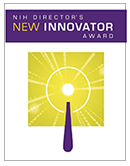
In the same way the world's continents are made up of countries that each contain multiple cities, your body's organs are made up of tissues which each contain multiple cell types. Tissue functions are influenced by the different cell types and their organization, gene activity patterns, and the molecular pathways they use to communicate with other cells. In recent years, detailed explorations of tissue function have been limited by an inability to map where and how individual cells function within the tissue. To address these limitations, Early Independence Awardee, Dr. Fei Chen, and New Innovator Awardee, Dr. Evan Macosko, teamed up to develop Slide-seq, a new method for mapping detailed data on which genes are turned on or off within individual cells.
The technology works like this: First, a surface is packed with DNA-barcoded beads. Next, fresh-frozen tissue is transferred on top of this surface and any RNA released is captured by the beads. RNA is used to measure gene expression— which genes are active in a cell. Scientists can use patterns of gene expression to tell the difference between cell types. Finally, by combining gene expression data with position information from the individual beads, the scientists created a high-resolution map of the spatial position of different cell types. The technique was validated with multiple tissues including those from the brain, liver, and kidney. The team confirmed that RNA expression measurements using Slide-seq agreed with other widely-used methods. To demonstrate its potential, the researchers used Slide-seq to map previously unknown gene expression patterns in an area of the mouse brain that had not been detected using existing technologies. They also used their novel technique to quantify different cellular responses in a mouse model of traumatic brain injury (TBI) over hours, days, and weeks. Their results suggested that TBIs can affect neural activity in a large area surrounding the injury for days or weeks post trauma.
Slide-seq technology may offer a better understanding of how different cell types organize themselves in space. This could allow us to map cells that are important after TBIs and other medically important events. However, more work is required to determine the significance of this organizational structure and how it changes over time. As part of this work, the NIH Common Fund's Human Biomolecular Atlas Program (HuBMAP) is developing an open, global research platform to map cells in healthy human bodies. Dr. Macosko joined the HuBMAP team in September of 2019 and will use Slide-seq to help create maps of the cell types and tissues that make up our bodies' "cities" and "countries."
Reference
- Slide-seq: A Scalable Technology for Measuring Genome-Wide Expression at High Spatial Resolution.. Rodriques SG, Stickels RR, Goeva A, Martin CA, Murray E, Vanderburg CR, Welch J, Chen LM, Chen F, & Macosko EZ. Science. 2019 Mar 29;363(6434):1463-1467



